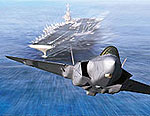Report: Lightning a threat to F-35
 Despite undergoing regular test flights, the F-35 Joint Strike Fighter, called the Lightning II, remains vulnerable to its namesake — lightning.
Despite undergoing regular test flights, the F-35 Joint Strike Fighter, called the Lightning II, remains vulnerable to its namesake — lightning.
Additionally, attempts to lighten the JSF by 11 pounds may have left the fifth-generation stealth fighter more vulnerable than the aircraft it will replace.
Those are among the findings of a new report from the Pentagon’s Operational Test and Evaluation office (OT&E), first obtained by Time magazine. Test flights are “not permitted” within 25 miles of known lightning conditions due to a needed redesign to the On-Board Inert Gas Generating System (OBIGGS), which maintains correct oxygen levels in the fuel tank. The system is crucial to protecting the engine from exploding in case of a lightning strike.
A poor design for the fuel tank venting system also means that when the single-engine jet is below 20,000 feet, its descent rate is limited to no more than 6,000 feet per minute.
“Neither restriction is acceptable for combat or combat training,” according to the report. The program is redesigning the OBIGGS system to compensate for these deficiencies.
Meanwhile, the removal of two safety features in an attempt to reduce weight on the F-35 have left the plane vulnerable to fuel explosions if hit by enemy fire.
“The program’s most recent vulnerability assessment showed that the removal of fueldraulic fuses, the PAO shutoff valve and the dry bay fire suppression, also removed in 2008, results in the F-35 not meeting the Operational Requirements Document (ORD) requirement to have a vulnerability posture better than analogous legacy aircraft,” officials wrote in the report.
The PAO shutoff was removed to save 2 pounds from the jet, but without it, a rupture in the area below the cockpit, such as that caused by a bullet fired during combat, would “likely cause an immediate incapacitation and loss of the pilot and aircraft.”
Similarly, the fueldraulic system, which is used to control the engine exhaust nozzle, was removed in 2008 to save 9 pounds. While the system leaves open the chance of a sustained fire if exposed, the program office “is accepting the increased vulnerability associated with the fueldraulic system and is currently not considering reinstating the fueldraulic fuses in the production aircraft configuration.”
Combined, the 11 pounds saved resulted in a “25 percent increase in aircraft vulnerability,” according to the findings of the report.
Testers also discovered a handful of cracks in the tested aircraft, including on the right wing and right engine of the F-35A variant, and multiple cracks on the bulkhead flange of the F-35B variant.
“All of these discoveries will require mitigation plans and may include redesigning parts and additional weight,” the testers found.
A spokeswoman for OT&E directed questions to the Pentagon’s Joint Strike Fighter program office, which did not return requests for comment.
Critics of the program, such as Ben Freeman of the Project on Government Oversight, view the new report as more proof that the JSF is “a broken record.”
“I think we still need to have far more oversight of the program,” Freeman said. “At some point, you’ve got to say that if these problems keep going, we have to slow down the buy.”
Robbin Laird, a consultant with ICSA, disagrees. He said this kind of report always lists the negatives, and called for live testing to continue.
“I don’t doubt that I can come up with a testing regime that the [F-16 or F/A-18] wouldn’t pass,” Laird said. “Why don’t we ask the pilots what’s going on? They’re the testers and developers.
“I want the users to come in and tell the designers what they want in the next iteration and sort out what’s possible,” Laird added.